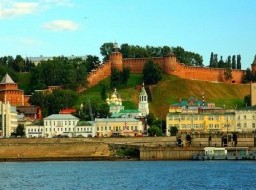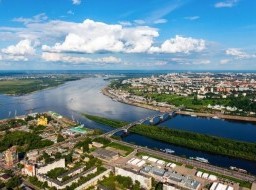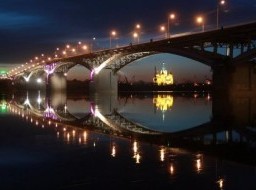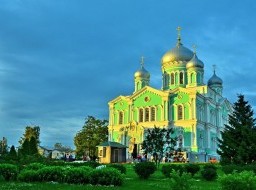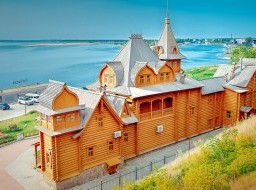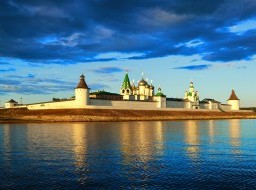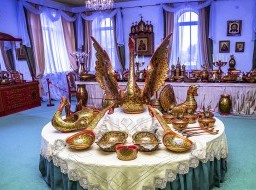Kozma Minin tombstone
Tombstone Minin - a plate that is located on the territory of the present Kremlin. It is dedicated to the militia leader, Kuzma Minin. Tombstone leader of the militia of Nizhny Novgorod in 1612 in the war for the independence of Russia Kuzma Minin is located near the building of the city administration (House of Soviets) on the territory of the Nizhny Novgorod Kremlin in Nizhny Novgorod district of Nizhny Novgorod, Nizhny Novgorod region. The inscription on the tombstone: "Summer 7124 (in 1616) reposed of the gentleman nobleman Kozma Minin Sukhoruk." This plate was installed in the Transfiguration Cathedral of the Nizhny Novgorod Kremlin at the burial site of Citizen K. Minin for donations of Nizhny Novgorod merchants in 1878. On November 4, 2012, the year of the 400th anniversary of the feat of the Nizhny Novgorod militia in 1612, the tombstone was returned to its historical place. Kuzma Minin (full name since 1613 - Kuzma (Kosma) Minich Minin, according to the Nikon chronicle - Kozma Minich Minin Sukhoruk, according to many writers - Kozma Minich Zakhariev Sukhorukiy, second half of the 16th century - May 21, 1616) - the organizer and one of the leaders of Zemsky militia 1611-1612 in the period of the struggle of the Russian people against Polish and Swedish intervention. Little is known about Minin's early years. There is an assumption based on local tradition (no later than the first half of the 19th century), that Kuzma Minin was the son of salt collector Mina Ankudinova from Balakhna. This version has an author - a prominent and serious historian IA Kiryanov, and before that the origin of Kuzma Minin from Mina Ankudinov was allowed by A. Ya. Sadovsky. The version about the Balakhna origin of the Minin (previously substantiated by the historian IA Kiryanov in 1965) is now being questioned; there are suggestions that the Balakhna Minin were only his namesake. Melnikov-Pechersky held similar views; In our time, a group of Nizhny Novgorod scientists put forward the corresponding statements in an article published in the 2005-2006 collection in the Minin Readings collection. In their view, the "Balakhna" version is not confirmed by a second study of documents from the Central Archive of the Nizhny Novgorod Region (memorial records and the Scribe Book). There is a version about the Tatar origin of Kuzma Minin was announced in 2002 by the magazine Ogonyok in the sidebar to the article of historian VL Makhnacha. The magazine called Kuzma Minin "the baptized Tartar Kirisha Minnibaev." But then, after verification, this material was never printed, and the material was lost. VA Kuchkin in his work "On the Kuzma Minin Family" (ISSSR, M., 1973. No. 2. P. 209-211) points to the monk Misail, inscribed in synodics for the remembrance of the Mininites, as a possible father people's hero. It is known for certain and is supported by accurate scientific data - it is a genealogical tree of the genus Kuzma Minin. Father - Mina, mother - is unknown, sons of Mina - Kuzma Minin (wife Tatyana Semyonovna, in monasticism of Taisia) and Sergey Minin, was at Mina and daughter Sophia (nun), their sister. At Nefed, the only son of Kuzma Minin and his wife Tatyana Semyonovna, the tree breaks off. Kuzma Minin is a great citizen, "elective of the whole earth" - the first democratically elected legitimate acting head of the Russian state, Nizhny Novgorod, a township man of Nizhny Novgorod, as he is called in the surviving documents of his time. In the beginning of the XVII century, Minin started a shop in Nizhny Novgorod and started meat trade. In 1608-1610, as part of the local city militia (led by the governor A. Alyabyev and A. Repnin), he fought in the battles with supporters of False Dmitry II. Nizhny Novgorod then managed to smash the Tushinites, cleanse them of the neighborhood of the city and gain combat experience. Details about the activities of Minin personally become known only in the autumn of 1611, when in Nizhny Novgorod read a letter from the patriarch Hermogen (but now some suggest that in reality they read the letter of the Trinity Monastery). At the city council, convened for discussion, the city council was attended by clergy and senior people in the city. Among the participants was Kuzma Minin, who was elected in September by the zemstvo (town) headman, a middle-class man and a butcher by trade. The next day after the meeting, the contents of the charter were read out to the citizens. Unnecessarily forgotten now, but in reality, headed together with Minin and Pozharsky, the Nizhny Novgorod militia patriot Protopope Savva persuaded the people "to become for the faith", but the speech of the Minin who spoke to him was much more concrete: "We want to help the Moscow state, so do not spare us our possessions, feel sorry for nothing, selling yards, wives and children to lay, beat the brow of someone who stood up for the true Orthodox faith and was our boss. " (SM Soloviev, History of Russia from Ancient Times, Volume 8. Chapter 8. The End of the Interregnum). In Nizhny Novgorod, constant meetings began: they talked about how to get up, where to get people and money. With such questions addressed primarily to Minin, and he elaborated on his plans. Every day his influence grew; Nizhny Novgorod was fond of Minin's proposals and, finally, decided to form a militia on a new basis, to convene service people and collect money for their maintenance. The leader of the militia chose Prince Dmitry Pozharsky, who was then treated for wounds in the Nizhny Novgorod estate and wished that the economic unit in the militia was entrusted to Minin. With the support of Pozharsky's troops, Minin carried out an appraisal of the property of the Nizhny Novgorod population and determined the part that should go to the militia. To Nizhny Novgorod soon joined and other cities raised by a well-known district charter, in the compilation of which, of course, Minin participated. In early April 1612 in Yaroslavl there was already a huge militia with Prince Pozharsky and Minin at the head. Kuzma entered the Council of the whole Earth, established in Yaroslavl in the middle of 1612 and before the convocation of the Zemsky Sobor in 1613, which served as the supreme body of state power, which he actually headed. On April 7, 1612, the Council of the whole earth called the Moscow state a great Russian power. But then the militia began to mow a terrible pestilence. Contrary to the expectations of the Semiboyar people, the militia did not run away, but thanks to competent sanitary measures the epidemic was stopped. Being convinced of the safety of the rear, the militia marched on Moscow. In the battles for Moscow on 22-24.08. (01-03.09) 1612 Kuzma also showed resourcefulness and military prowess. In August, with the personal participation of Minin, Khodkevich was defeated, and in October Moscow was cleared of Poles. Kuzma Minin, along with Dmitry Timofeyevich Trubetskoi and Dmitry Mikhailovich Pozharsky, ruled the great Russian state until the Zemsky Sobor convened, since after the unification of the Soviets of all the land of the First and Second Militia as a result of the capture of Moscow and the final unification of the militias, the Council of the whole earth was not going to. Like all the Grand Dukes, the tsars and rulers of the Moscow State before Peter I "the elective of the whole earth" Kuzma Minin himself did not sign anything. All the charters, for example, about the convocation of the Zemsky Sobor, his comrades Trubetskoi and Pozharsky signed for him. The day after the wedding of the kingdom (July 12, 1613), Mikhail Fedorovich granted Minin the rank of a nobleman and an estate. In the Duma there were only two Duma noblemen appointed by the False Dmitri I, but proclaimed at the Zemsky Sobor all Rurikovichs as foreigners as Prince Vladislav and who made it possible for Mikhail Romanov to be elected a relative of the Romanovs Gavrila Pushkin with a salary of 120 rubles and the only one appointed by Mikhail himself was Kuzma Minin with a salary of 200 rubles. Meeting since then, constantly in the Duma and living in the royal palace, Minin enjoyed great confidence in the king and received the most important "parcels". He died in 1616, "during the search" in "Cossack places" (where the population of the former Kazan khanate bore Cossack service to the proclaimed great Russian state) on the occasion of the Tartar uprising and the Cheremis. |

